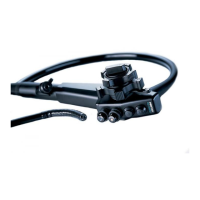- 16 -
6) Procedures involving poorly prepped patients should be avoided as excessive patient material can negatively
affect certain scope channel functions as well as the ability to maintain a clear endoscopic view.
7) Mucous, fluids and/or other patient material should be aspirated via the instrument/suction channel and suc-
tion control valve to improve visualization. Maintain a clear view during aspiration, avoid prolonged suction
time and use the minimum level of negative pressure required to perform the clinical procedure.
8) The objective lens may be cleaned during the procedure by alternately using the air/water and suction control
valves.
9) Image capture, hard copy documentation, video recording, etc. may be carried out as necessary.
10) Before withdrawing the scope, trapped air should be suctioned to reduce patient discomfort.
11) When attempting to withdraw the scope, return the deflection locking levers to their free position. Always
withdraw the scope under direct visualization.
NOTE:
Be careful not to deliver too much air.
WARNING:
It must be recognized that variations in air flow (pressure and volume) for patient insufflation may exist
from one manufacturer’s equipment (processor and/or scope type) to another. It is, therefore, important
to closely monitor the patient at all times and to aspirate excessive air to prevent overinsufflation and
potential pneumatic perforation.
WARNING:
Do not apply excessive negative pressures (high suction settings) and/or prolonged contact of the distal
instrument channel opening (scope tip) against mucosal surfaces to avoid “suction polyps”, bleeding
and/or other trauma to the patient. During aspiration keep as clear as possible an endoscopic view of
patient anatomy and maintain some distance from scope tip to tissue to avoid suctioning of mucosa
onto/into the distal channel opening.
NOTE:
Continuing use of the light guide with sticky debris might cause steam because debris is deprived of
moisture by heat. If steam is found on the light guide during a procedure, stop it immediately, and with-
draw the scope carefully from a patient.
NOTE:
Should debris on the objective lens be difficult to clean, one can temporarily use the HIGH air pressure
setting on the processor and simultaneously press the air/water and suction control valves. Return air
pressure setting to original selection before proceeding.
UP/DOWN DEFLECTION LOCK
RIGHT/LEFT
DEFLECTION LOCK
FREE POSITION
(LOCK RELEASED)
FREE POSITION
(LOCK RELEASED)
LOCK POSITION
LOCK POSITION
WARNING:
If for any reason, the image is lost due to power
shortage, lamp or processor failure, etc. the
deflection locking levers should be released, the
scope tip should be straightened to its neutral
position, and the insertion tube should be care-
fully and slowly withdrawn from the patient.

